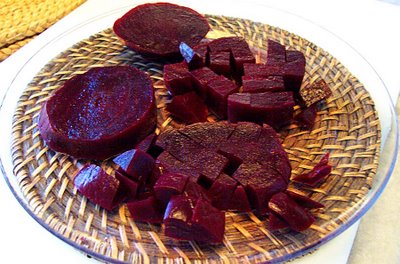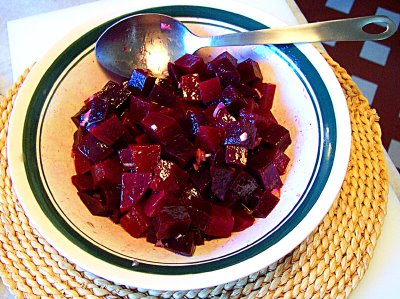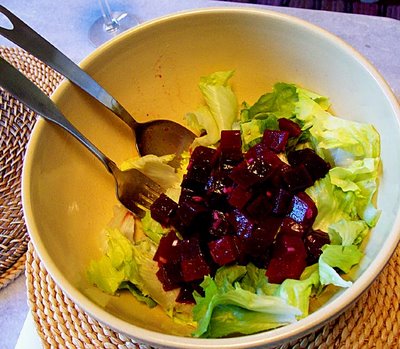So what is it about beets? How could something so good, in my opinion, inspire such revulsion in so many others? Some of my best friends — Cheryl, John, Francis — find them inedible. Isabella said she doesn't eat them either. And Marie told me she will eat them but not with gusto.
 Betteraves cooked, sliced, and cut into cubes for salad
Betteraves cooked, sliced, and cut into cubes for saladOur friend Sue said she had never been able to eat them either, until she tried fresh beets rather than the ones out of a can. Maybe that's a little like mushy canned asparagus vs. the nice fresh ones. Now Sue eats beets with pleasure, she says. But cooking them is a lot of trouble, I think, or at least takes a lot of time.
 Some chopped shallot or onion adds good flavor
Some chopped shallot or onion adds good flavorI should point out that beets are called
bettteraves in French, so that those who detest them can avoid ordering them. But heed my words: if there's a vegetable you think you don't like, try the French version of it when you are in France. You might change your mind. The climate, the growing methods, the serving styles, and the freshness of the vegetable in France can make an incredible difference in the taste compared to what you've had in the States.
Of course, I can't think of a vegetable I don't like. Even though I more often post recipes for and pictures of meat dishes, I never neglect the veggies or some green salad in my meal plans. In California, I worked at Apple with a woman who said she was a vegetarian. But she also pointed out that she didn't really like or eat vegetables. I think she survived on bread, pasta, and cheese. Maybe salad. She looked healthy enough and had a great sense of humor (I say that because French people stereotype vegetarians as humorless).
Walt says beets have
un goût particulier — a taste all their own. He likes them, but he says they "taste like dirt." I can see what he means, but maybe it would be more appetizing to say something fancier, like "the taste of the earth they are grown in." Some wines taste like dirt... er, the earth... too, but that can also be a good taste.
Terroir, you know.
 Add vinegar and some good oil with salt and pepper. Stir and let marinate.
Add vinegar and some good oil with salt and pepper. Stir and let marinate.The nice thing about French beets is that they are sold pre-cooked. Some are shrink-wrapped, but I avoid those. The best ones I've found around here are the ones at Intermarché, displayed in a wooden crate with a big "meat fork" you can use to serve yourself without getting red stains on your hands. You also find them cooked at the farmers' markets.
Once beets are cooked, you can just hold them under running water and rub the rough skin right off. A little trimming with a paring knife and they're ready. I like them cubed with some chopped shallot, oil, vinegar, salt, and pepper. My mother and a lot of other Americans eat them pickled, that is just with vinegar. I think that's a little sharp, myself.
 Serve some of the beets with bitter salad greens. The beets' sweetness
Serve some of the beets with bitter salad greens. The beets' sweetness
complements the greens perfectly — to my taste.Beets dressed with oil and vinegar are an especially good complement (for those who can stand them) to salad greens that have some bitterness in them — escarole, curly endive (
salade frisée in French), Belgian endive, arugula (
roquette), or dandelion greens (
pissenlits).
Ginny just gave me what sounds like a good recipe for a beet & walnut spread made with cooked beets:
Take about a pound of beets, cook them and peel them. Grind/process them with 1 cup shelled walnuts. In a small bowl, mince 1 or 2 cloves garlic. Add some salt (~½ tsp). Add 1 Tbsp oil and 2 Tbsp red wine vinegar. Mix and add to beet/walnut mixture. Add a little paprika and serve as a spread for bread, crackers, vegetables.
You can also eat beets raw. Our friend Adrienne in Amboise once grated whole raw beets the way you can grate raw carrots, and then dressed them with oil and vinegar. They were delicious, I thought. Maybe people who don't like cooked beets would like them served that way.
One of the things I've always liked about standard French food is what is called
une assiette de crudités. It's a plate of mostly raw vegetables (but some cooked, like beets), including grated carrots (
carottes râpées), sliced cucumbers, sliced tomatoes, sliced raw mushrooms, and shredded raw green or red cabbage. The vegetables are dressed with a good mustardy vinaigrette. (Another component of such a dish, which is served as an appetizer, is shredded celery root with a mustardy mayonnaise sauce (in French,
céleri rémoulade.)
 Une salade de scarole et de betteraves
Une salade de scarole et de betteravesI much prefer a French salad plate, where the individual items are prepared so that they are of the right texture and size, to the American tossed salad that sometimes contains big chunks of raw carrot, raw celery, raw onion, and raw green pepper. Or even to vegetable trays with raw celery stalks, raw carrot sticks, and raw bell peppers.
Maybe those kinds of rough-and-tough salads are the reason a lot of Americans call salad "rabbit food" and won't eat it. Vegetables served that way can be hard on the digestive system.
I don't think I ever enjoyed eating beets until I came to France. It's all in the presentation and dressing, I guess. But then I first came to France in 1970 and I have been enjoying things like
salade de betteraves,
carottes râpées, and other
crudités ever since.
 The light brown squares on the cutting board are the rind of the pork
The light brown squares on the cutting board are the rind of the pork L. to r., lamb, garlic, mushrooms, rosemary, parsley, lardons, carrots, celery,
L. to r., lamb, garlic, mushrooms, rosemary, parsley, lardons, carrots, celery, After cooking all the meat and vegetables, moistened with the lamb drippings,
After cooking all the meat and vegetables, moistened with the lamb drippings, Serve some of the beets with bitter salad greens. The beets' sweetness
Serve some of the beets with bitter salad greens. The beets' sweetness The good news in all this is that the temperatures are very mild. But all the rain means the garden and yard are not yet cleaned up the way I would like for them to be.
The good news in all this is that the temperatures are very mild. But all the rain means the garden and yard are not yet cleaned up the way I would like for them to be. This is the kind of cooking I really enjoy doing, and the kind of food I enjoy eating. It's country cooking, and it's comfort food. I can spend hours in the kitchen washing, peeling, and cutting up vegetables when I know I'm going to get to eat them later.
This is the kind of cooking I really enjoy doing, and the kind of food I enjoy eating. It's country cooking, and it's comfort food. I can spend hours in the kitchen washing, peeling, and cutting up vegetables when I know I'm going to get to eat them later. Then I pushed them to the side and put in some big chunks of beef (stew beef, I guess we would call it — it's bœuf à bourguigon in French) to brown them. I did the beef in two batches so it wouldn't be crowded in the pan. I let it brown on each side for maybe 5 to 7 minutes.
Then I pushed them to the side and put in some big chunks of beef (stew beef, I guess we would call it — it's bœuf à bourguigon in French) to brown them. I did the beef in two batches so it wouldn't be crowded in the pan. I let it brown on each side for maybe 5 to 7 minutes.



 a whole leek in the refrigerator, and some Belgian endives. I washed the leek and cut it into two big pieces (white part only — I save the green tops for making stock). I trimmed up four endives. I opened the oven, took off the cover, laid those extra vegetables over the top of the others, basted all with the sauce, turned the heat down to about 325ºF (160ºC), put the cover back on, and now I'm letting it all cook for about another hour. That'll be about 2½ hours in the oven, in total.
a whole leek in the refrigerator, and some Belgian endives. I washed the leek and cut it into two big pieces (white part only — I save the green tops for making stock). I trimmed up four endives. I opened the oven, took off the cover, laid those extra vegetables over the top of the others, basted all with the sauce, turned the heat down to about 325ºF (160ºC), put the cover back on, and now I'm letting it all cook for about another hour. That'll be about 2½ hours in the oven, in total.





 Rye bread for 90 U.S. cents a loaf, or $1.38 a pound,
Rye bread for 90 U.S. cents a loaf, or $1.38 a pound,